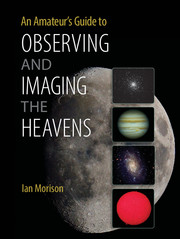Book contents
- Frontmatter
- Dedication
- Contents
- Preface
- Acknowledgements
- Prologue A Tale of Two Scopes
- 1 Telescope and Observing Fundamentals
- 2 Refractors
- 3 Binoculars and Spotting Scopes
- 4 The Newtonian Telescope and Its Derivatives
- 5 The Cassegrain Telescope and Its Derivatives
- 6 Telescope Maintenance, Collimation and Star Testing
- 7 Telescope Accessories
- 8 Telescope Mounts
- 9 The Art of Visual Observing
- 10 Visual Observations of the Moon and Planets
- 11 Imaging the Moon and Planets
- 12 Observing and Imaging the Sun
- 13 Observing and Imaging with an Astro-Video Camera
- 14 DSLR Deep-Sky Imaging
- 15 Imaging with Cooled CCD Cameras
- 16 Auto-Guiding and Drift Scan Alignment
- 17 Spectral Studies
- 18 Improving and Enhancing Images in Photoshop
- Index
- Plate Section
15 - Imaging with Cooled CCD Cameras
Published online by Cambridge University Press: 05 June 2014
- Frontmatter
- Dedication
- Contents
- Preface
- Acknowledgements
- Prologue A Tale of Two Scopes
- 1 Telescope and Observing Fundamentals
- 2 Refractors
- 3 Binoculars and Spotting Scopes
- 4 The Newtonian Telescope and Its Derivatives
- 5 The Cassegrain Telescope and Its Derivatives
- 6 Telescope Maintenance, Collimation and Star Testing
- 7 Telescope Accessories
- 8 Telescope Mounts
- 9 The Art of Visual Observing
- 10 Visual Observations of the Moon and Planets
- 11 Imaging the Moon and Planets
- 12 Observing and Imaging the Sun
- 13 Observing and Imaging with an Astro-Video Camera
- 14 DSLR Deep-Sky Imaging
- 15 Imaging with Cooled CCD Cameras
- 16 Auto-Guiding and Drift Scan Alignment
- 17 Spectral Studies
- 18 Improving and Enhancing Images in Photoshop
- Index
- Plate Section
Summary
The latest DSLR cameras can do a very good job of astro-imaging and can, of course, be used for general photography as well, so why go to the expense of buying a cooled CCD camera? The main reason lies in the word ‘cooled’. All imaging chips produce dark current noise which increases with exposure time and is also highly dependent on its temperature, that of a typical chip dropping by half for each drop of 6 degrees Celsius in temperature. So, if the chip is cooled by 30 degrees below ambient temperature, the dark current noise will have dropped by about 5 times, so allowing longer exposures to be taken before dark current noise becomes a problem. Given dark skies that do not suffer from light pollution, this can allow images to reveal faint nebulosity that would otherwise be lost in the noise. When significant light pollution is present, the exposure times, and hence the dark current contribution, have to be less, before the skylight becomes obtrusive, and so cooling does not confer as great an advantage. The latest chips have very low dark currents, and it is rarely worth cooling them down below about –20 C. This temperature can normally be reached with the single-stage Peltier cooling employed in CCD cameras aimed at the amateur market.
Chip Size
The dimensions of the CCD chip allied to the scope’s focal length dictate the field of view of the resulting images. The chip dimensions in millimetres divided by the focal length in millimetres give the field of view in radians. Multiplying this by 57.3 gives the field of view in degrees. So, obviously, a bigger chip will provide a bigger field of view. For example, my 80-mm refractor has a focal length of 550 mm, and this is used with a CCD camera whose sensor has dimensions of 18 × 13 mm. This gives a field of view of 1.9 × 1.4 degrees.
- Type
- Chapter
- Information
- An Amateur's Guide to Observing and Imaging the Heavens , pp. 243 - 267Publisher: Cambridge University PressPrint publication year: 2014



